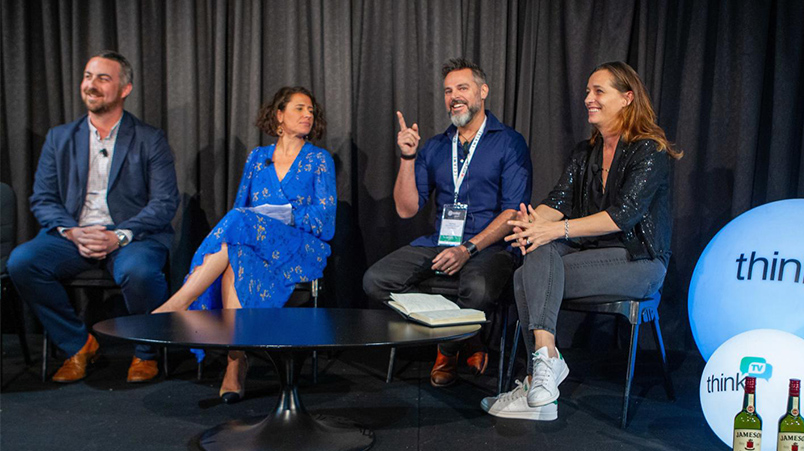Screens and screamers: The best one-liners from The Future of TV Advertising Forum

L to R: Tubi's Tyler Fitch, Seven's Charlotte Valente, VMLY&R Paul Nagy and GroupM's Nic Lewis, The full-day event featured clients, agencies and owners, all weighing in on what lies ahead for the evolving TV sector.
Here's the fast and furious version of this year's Future of TV Advertising Forum, which pulled 500-plus marketing, agency and media types on what next for TV, in all its forms. Take a tour of our curated selection of quotes for the time-poor on BVOD, overloaded adloads, the streaming invasion, VOZ, martech mistakes, pitching problems and misguided marketing mindsets.
"What is the second-largest streaming platform in Australia? Number one, of course, is Netflix. Looking at it you might say it's Stan but I'm going to say no, it's not. It's a hypothetical platform that doesn't yet exist...each BVOD platform has an average reach of 16% individually, but when combining those who watch two or more of those services you get a reach of 34%, meaning the FTA broadcasters are the second-biggest streaming platform in Australia [collectively]. Therein lies an opportunity for broadcasters."
"If you want to know how to create a stampede [towards BVOD] rather than a trot, we need to tell clients to stop spending so much on YouTube. In some instances we are seeing 80% of video budgets going into the platform, that's absolutely bonkers. 80% is too much, so, stop."
“This product [VOZ], it’s not a funnel into any marketing proposition. It’s a flywheel. And that flywheel is about attract, engage and delight. We’ve attracted, we’re engaging, we need to delight. "
“While we won’t oversell and over-promise, because it is a journey, the results are pretty amazing and we should, in Australia, be very, very proud of what we’ve achieved."
"The client spends over $500m around the world and the Australian team’s contribution to that review was nine cells on one Excel spreadsheet of some unit costs. But we’re probably the third most important market for that client in the world."
"Searching for the right thing to watch is becoming overwhelming. In the US it takes people an average of seven minutes to decide what to watch in the SVOD environment. By that time, my food has gone cold."
"The very idea of captured audiences is very much like the concept of mild summers, it's in the past. It's not going to happen anymore. We're obsessed with the audience, we should be just as interested in creative that can hold their attention during ads."
Paul Nagy of VMLY&R provides the creative agency point of view on the future of TV ads. Nagy, naturally, says it's all about the creative: if premium content such as Apple TV's Morning Wars cant' hold his teenage daughter's attention and keep her from checking her phone, what luck does 'average' advertising have in the world of TV?
"There's a difference between what audiences will tell you what they watch and what they actually watch. Really understanding what content is going to engage them - not just capture their attention - is paramount."
Seven's new CMO Charlotte Valente told the crowd it is a marketer's role to focus all their attention on audience when it comes to TV. On the back-end, she acknowledged that better metrics are required to enable brands to continue to demonstrate TV's brand building attributes.
"The pureplay AVODs are more than happy to see the SVODs battle it out and spend billions of dollars creating the top 1% of content, because the rest of the 99% are happy to watch content that Netflix had locked up [in longstanding] deals. We continue to be that extra avenue for people to monetise content - and it's only looking better as the fight for SVOD continues to get bloodier in the next six months."
"If you at look at how clients work now, many have a multi-tiered approach to TV: sponsorships, brand integrations and traditional breaks. We speak a lot about this notion of brand coming back and at GroupM, we've seen a lot of people come into that space, because the content that is being created is so good."
“Customers we are losing at Foxtel are the low-value ones that in the last five years, we probably shouldn’t have chased. The $26 basic package at Foxtel is not a great experience. I can tell you from a capital and income standpoint, it’s not an experience we want either."
"If you start launching advertising product and inventory and shoving it down people's throats, you'll immediately lose those customers. And if like us and your product is paid for, then they'll never come back.


